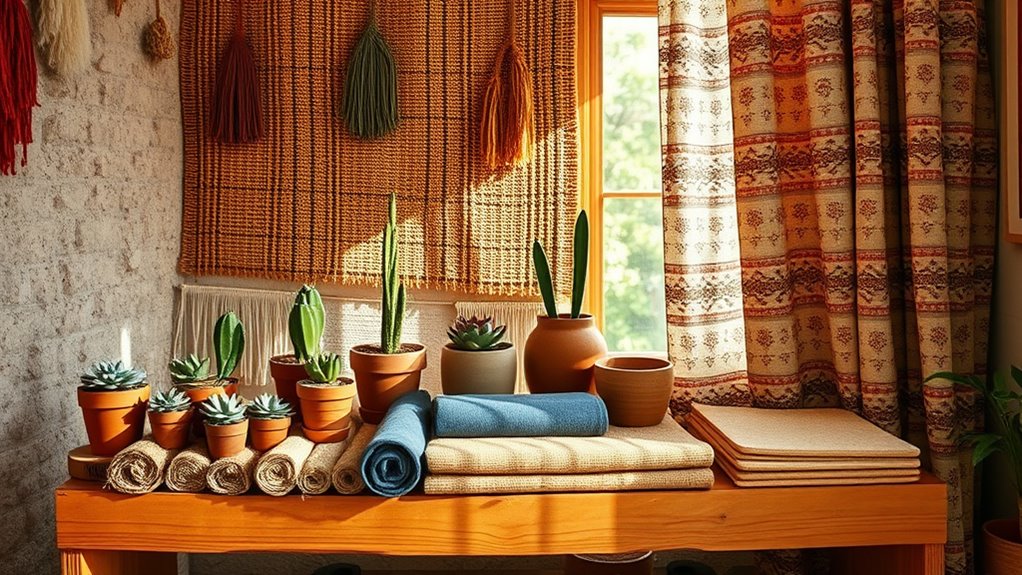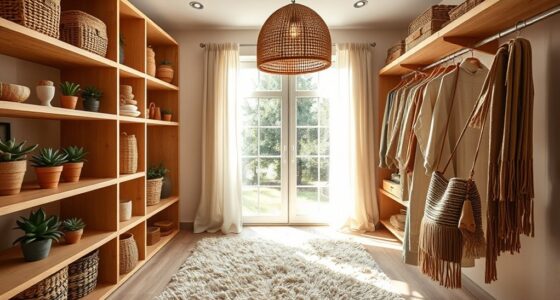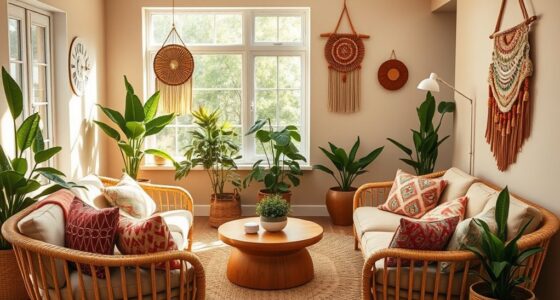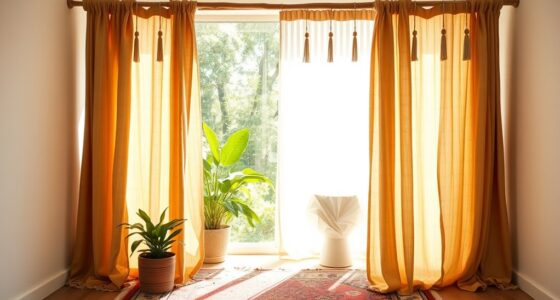To select sustainable insulation for your boho home, opt for natural fibers like wool, hemp, or cotton, which add texture and eco-charm. Recycled options such as denim or fiberglass are also great for reducing waste and conserving resources. Look for locally sourced materials to cut down on emissions and support your community. Proper installation guarantees efficiency, so explore your options further to find the perfect balance of style, comfort, and sustainability.
Key Takeaways
- Opt for natural fiber options like hemp, wool, or cotton for eco-friendly, biodegradable insulation that enhances boho aesthetic.
- Choose recycled insulation materials such as denim or fiberglass to reduce waste and minimize environmental impact.
- Prioritize locally sourced insulation to cut down on transportation emissions and support regional sustainability.
- Ensure proper installation for optimal thermal performance and indoor air quality benefits in boho-inspired spaces.
- Select textured, colorful, or eco-conscious insulation options that complement boho decor while promoting sustainability.
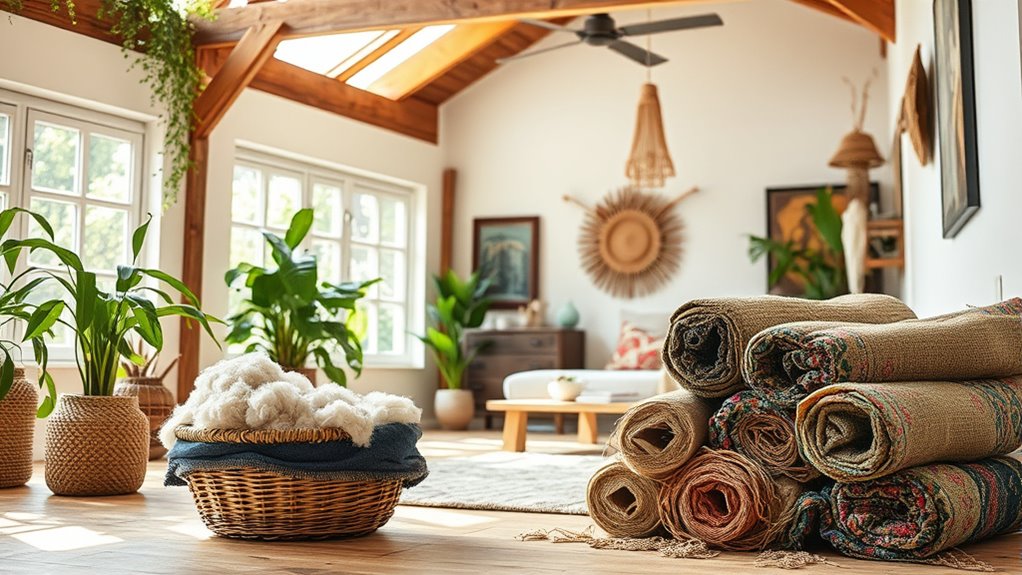
When selecting insulation materials for your home, prioritizing sustainability can make a significant difference for the environment and your long-term energy savings. One of the best ways to do this is by choosing options like recycled insulation, which uses repurposed materials such as old newspapers, cardboard, or plastic bottles. These materials divert waste from landfills and reduce the demand for virgin resources, minimizing your home’s environmental footprint. Recycled insulation not only helps conserve natural resources but also often offers comparable thermal performance to traditional options. It’s a smart choice if you’re committed to eco-friendly living and want to incorporate sustainable practices into your home design.
Choosing recycled insulation helps reduce waste and conserve resources while maintaining effective thermal performance.
Natural fiber options are another excellent sustainable choice. These materials, derived from renewable plant sources, include hemp, wool, cotton, and cellulose. They’re biodegradable, non-toxic, and generally have a lower embodied energy compared to synthetic insulation. Wool insulation, for example, is naturally fire-resistant and regulates humidity, creating a healthier indoor environment. Hemp and cotton fibers are durable and sustainable, especially when sourced responsibly. Cellulose insulation, made from recycled paper, offers an effective thermal barrier and is treated with environmentally friendly fire retardants. Choosing natural fibers aligns perfectly with the boho aesthetic, emphasizing organic textures and earthy materials, which add warmth and character to your home.
When considering recycled insulation and natural fiber options, it’s important to evaluate their performance and installation requirements. Recycled fiberglass or denim insulation, for example, can be installed much like traditional fiberglass, but with a lower environmental impact. Natural fiber insulations may require specific handling or installation techniques to maximize their effectiveness, but they often come with the benefit of better indoor air quality and fewer chemical emissions. Additionally, many of these materials are harvested or produced locally, reducing transportation emissions and supporting local economies.
Incorporating sustainable insulation into your boho home doesn’t mean sacrificing style or comfort. Many natural and recycled options come in a variety of textures, colors, and finishes that complement bohemian interiors. Their tactile qualities add depth and character, enhancing your space’s cozy, eclectic vibe. By choosing recycled insulation and natural fiber options, you’re making a conscious decision to reduce environmental impact while creating a warm, inviting, and uniquely styled home. It’s a simple yet impactful way to align your living space with your values, ensuring that your home is both beautiful and sustainable for years to come.
Frequently Asked Questions
How Does Insulation Impact Indoor Air Quality?
Insulation directly impacts your indoor air quality and health. Poor-quality or synthetic insulations can release volatile organic compounds (VOCs), which may cause respiratory issues or allergies. When you choose eco-friendly, non-toxic insulation, you improve air quality and reduce indoor pollutants. Proper insulation also prevents drafts and moisture buildup, creating a healthier environment. So, selecting the right insulation helps maintain indoor health and guarantees cleaner, safer air inside your boho home.
Are There Eco-Friendly Insulation Options Suitable for All Climates?
Yes, eco-friendly insulation options suit all climates, but you should consider recycling challenges and material sourcing. For instance, cellulose insulation is made from recycled paper, making it sustainable, but sourcing can be limited in some areas. Wool and hemp are natural options, offering good insulation across climates. Always check local availability and recycling opportunities to guarantee your choices are truly eco-friendly and suitable for your home’s environment.
What Is the Lifespan of Sustainable Insulation Materials?
Sustainable insulation materials typically last between 20 to 100 years, depending on their type and installation. You should consider recycling methods and material durability when choosing. For example, cellulose insulation can be recycled and tends to be durable if properly maintained, while cork insulation also offers longevity. Regular inspections help guarantee your insulation maintains its effectiveness over time, reducing the need for frequent replacements.
Can Sustainable Insulation Be Installed DIY?
Yes, you can attempt DIY installation of sustainable insulation, but beware of eco-friendly challenges that may arise. It’s tempting to save money and time, yet improper installation risks reducing energy efficiency and damaging the environment. Carefully research your chosen material, follow safety guidelines, and consider consulting experts if needed. While DIY can be rewarding, make certain you’re prepared for the intricacies to truly benefit from eco-friendly practices.
How Do Costs of Eco-Friendly Insulation Compare to Conventional Options?
You’ll find that eco-friendly insulation options often cost more upfront than conventional materials, but a clear cost comparison shows they can be worth the investment. While budget considerations are important, sustainable insulation’s energy savings and environmental benefits can offset higher initial costs over time. By evaluating your long-term savings and environmental impact, you can make smarter choices that align with both your budget and eco-conscious values.
Conclusion
So, next time you’re tempted to go for the cheapest insulation, remember—choosing sustainable materials isn’t just eco-friendly, it’s also the smart move. After all, what’s more ironic than saving a few bucks now and paying for it later with higher energy bills and environmental harm? By opting for eco-conscious insulation, you’re not just building a stylish boho home—you’re actually investing in a greener, more sustainable future. Now, isn’t that the real luxury?
